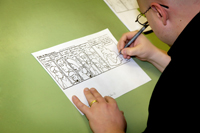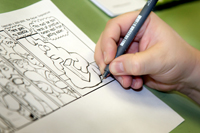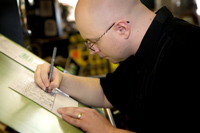Howard Tayler

How did you get started with art?
I’ve been an artist of some flavor or another for as long as I can remember. A little over nine years ago, I realized that I wanted to write a comic strip and simultaneously convinced myself that the art part wouldn’t be that hard to pick up. So I taught myself to draw. If you look at Schlock Mercenary strips from June of 2000, it should be immediately apparent that I was both misguided and untalented. Fortunately, I loved it enough to stick with it, and I’m just barely smart enough to figure out where to focus my practicing.
How did you become a cartoonist?
I guess I became a cartoonist by deciding one day that was what I was. I looked at the work of other cartoonists and modeled my processes and output after what I thought they must be doing. As it turns out, my modeling was flawed. But my process worked rather spectacularly, if not flawlessly.
What other cartoonists have influenced your work?
Bill Watterson (Calvin and Hobbes), Berkeley Breathed (Bloom County), Gary Larson (The Far Side), and Bill Amend (FoxTrot). I suppose I could ramble for 5,000 words about where I see their influences in my own work, but I shall force myself to summarize: Watterson showed me movement. Breathed showed me the satirical form I would adopt. Larson epitomized cognitive humor. Amend wrote a tutorial on the web, long since lost to link rot, which gave me the fundamentals from which my own process would evolve.

What’s your work process?
Hah! Another 5,000-word essay forced into a summary: I muse upon the overall story I want to tell (about a year’s worth of comics) and then start breaking it into chunks. These may be arcs, character arrivals, iconic moments, or lists of things that have to be foreshadowed. Then for the next year I write and illustrate comics along the outlines of those chunks, refining the outline as I go. I write a week of scripts, print them on 8.5×14″ paper with the panels and dialogue in position, and then pencil right on the scripts. I ink over the top of my pencils, erase the pencil lines, and then scan the resulting black-and-white line art into Photoshop for coloring. Once strips have been digitally colored, they’re uploaded into a queue, so they’ll appear on the appropriate date once that date arrives.
Tell us about being a full-time web cartoonist. What’s a normal day like?
“Normal” depends on what day of the week it is and where I am in the book release schedule. I guess that means that “crunch mode” days aren’t normal, nor are days in which I have to sign and sketch a hundred books. Monday mornings, I sit down to script a week of comics, and then Monday afternoons I set out to pencil them. On Tuesdays, I try to get those pencils all inked. By Wednesday afternoon I should have an entire week of comics scripted, penciled, inked, colored, and uploaded. The remaining three days of the week get spent on various business tasks, including re-coloring old strips for print collections, knocking down a second week of comics so I can take the occasional vacation, or (as was recently the case) frantically drawing pictures for the Tracy Hickman RPG supplement I agreed to illustrate.
How do you balance work and family obligations?
How does anybody balance work and family? Family comes first, but sometimes family activities need to be scheduled around less flexible scheduling demands of work. I’m kind of a workaholic, so I have to remind myself not to feel guilty when I ditch work for a couple of hours to flop down with the kids on the couch, or go see a movie, or hit the park or something. That’s really the only trick—telling my Type A, overachieving hindbrain that the current non-work activity is critical because it’s what the work is there to support.

What does it take to make ends meet as a cartoonist?
At the outset, you must learn to live in such a way that the ends begin closer together than you perhaps think necessary. The remainder is what I’ve described in the past as a recipe for Grizzly Bear Soup. First, kill a grizzly bear. Second, any old soup recipe will do, since you’ll be using the bear.
In non-metaphorical terms, the grizzly bear is the tens of thousands of readers who like your work enough to spend money on it. Finding those readers is the hard part. Once you’ve done that, the rest is easy: just run a decent business. There are a zillion books out there on just that. “How to Make Webcomics” is probably the definitive tome for my industry. If you’re not business-minded, though, you’ll want to learn from somebody who is.
Tell us about creating Schlock Mercenary.
Well, I like science fiction, and I figured a good science fiction comic strip would need a regular cast of characters with an excuse to do exciting things, so I made them mercenaries. The rest just grew out of the process of creating interesting characters and finding out that they were mapping themselves onto the voices in my head.
What advice would you give to aspiring LDS cartoonists?
My advice for aspiring LDS cartoonists is the same as my advice to aspiring cartoonists of any creed: be a cartoonist because it’s what you want to do, not because you want fame or fortune. Draw the pictures you want to draw, tell the stories you want to tell, and if that resonates with an audience large enough to support you, then you will have the opportunity for a happy and fulfilling career. If not, well, you’re still doing something you like with your free time, right? I’d hate to see anybody trying to be a cartoonist with a strictly commercial approach in which they target some niche or another and end up writing comics they hate in order to collect a paycheck.

Tell us about going to conventions like Life, The Universe, and Everything (LTUE). What are the highlights for you?
My favorite part of conventions is the wads of untraceable cash that people spend to buy books. Wait, no, I stole that line from my friend Phil. My favorite part is going to panels and talking about stuff. I love a good discussion. I also enjoy meeting with fellow professionals, especially those with whom I’ve become friends, because when we talk about stuff, we laugh a lot. I like laughing. My favorite moments from this most recent LTUE had laughter in them.
What influence does gaming have on your work?
Gaming is an imagination outlet. It’s a form of shared storytelling, and it forces me into a different mindset. Role-play is what you make of it, and I believe it to be an inherently good thing. I remember doing role-play in the MTC and not having the heart to tell our instructor that this was basically a game of Dungeons & Dragons in which we were pretending to be missionaries.
How do you feel about your Hugo nomination for Best Graphic Story?
I feel simultaneously humbled and exalted. My work is being held up for examination alongside the work of a dozen other professionals, and the attention is wonderful, but I honestly believe that their work is quite a bit better than mine. I’m thrilled. I love to read stories in which justice, truth, and honor take the prize, but I’d also like to actually win the award myself. So let’s add “hypocritical” to the list: humbled, exalted, and at least a little bit hypocritical.

How has the gospel influenced you in your work?
The biggest help has probably been that I’m happy. Knowing something to be true, knowing that life has purpose, knowing that my family will be with me forever—these and other gospel gifts are meant to help us to live happily. I do, and my work reflects that. I write to make people laugh and to help them be happy.
How do you see your art helping build the kingdom?
I try to avoid any sort of direct proselyting in my work, and the only subliminal form I’m capable of is “Hey, look, the cartoonist seems like he’s a nice enough guy: upstanding, good family man, hard worker. Oh, and he’s a Mormon. Maybe there’s something to that after all.” It’s the weakest sort of attractor, but I believe it’s also the longest lasting. It’s like gravity: on the subatomic level it is insignificant, but when you stand way back it’s what causes planets, stars, and galaxies to happen.
Where do you see your work going in the future?
I plan to be cartooning for decades to come. I hope to see my audience grow to the point that those who like good science fiction have at least heard of Schlock Mercenary and decided for themselves whether the strip is any good. How many people is that—ten million? Fifty? How far in the future are we talking about? I’ve already shipped books to customers on all seven continents. I guess my next goal needs to be getting the guys on the ISS to read Schlock online. Do they have internet access up there? From there, the moon. ❧
